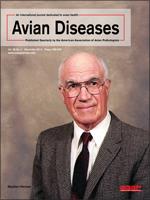The virulence of pigeon paramyxovirus type 1 (PPMV-1) for different species of birds was investigated in two independent sets of experiments in which groups of pigeons, chickens, turkeys, quails, and geese (10 birds per group) were inoculated with 106 median embryo infectious doses of PPMV-1 isolate: 1) nonpassaged (nPPMV-1, intracerebral pathogenicity [ICPI] value = 1.27) and 2) after six passages in specific-pathogen-free chickens (pPPMV-1, ICPI = 1.46) via the oculonasal route. Naive birds were placed in contact with infected birds (two birds per group) to monitor virus transmission. Clinical observation was performed daily. Additionally, cloacal swabs, oropharyngeal swabs, and selected organ samples were collected on days 2, 4, 7, 10, and 14 postinfection and tested by real-time reverse transcriptase–PCR for estimation of viral shedding and distribution in tissues. Infected pigeons exhibited nervous and digestive tract symptoms, mortality, shedding, and transmission to contact birds. Chickens, turkeys, quails, and geese did not exhibit any clinical signs regardless of the PPMV-1 strain used for inoculation. However, in contrast to quails and geese, chickens and turkeys shed the virus via the oral cavity and cloaca, and transmission to contact birds was also observed. Viral RNA was identified in tissues collected from all pPPMV-1–infected birds, whereas negative results were obtained in the case of tissues taken from nPPMV-1–infected quails and geese. We conclude that the PPMV-1 used in this study was most virulent to pigeons, followed by chickens and turkeys, while quails and geese seem to have the highest level of innate resistance to this strain. However, passaging of PPMV-1 in chickens resulted in the increase of ICPI and noticeable but sometimes contrasting changes in the replication capacities of the virus.
Infección experimental en diferentes especies de aves con un paramixovirus de las palomas tipo 1. Evaluación de resultados clínicos, de la eliminación viral y la distribución en los tejidos.
Se estudió la virulencia de un paramixovirus de las palomas tipo 1 (PPMV-1) en diferentes especies de aves mediante dos grupos de experimentos independientes en los que se inocularon palomas, gallinas, pavos, codornices y gansos (10 aves por grupo) con 106 dosis infectantes para embrión de pollo 50% de un aislamiento sin pasaje en pollos (nPPMV-1, con un índice de patogenicidad intracerebral [ICPI] de 1.27) y con el mismo virus después de seis pasajes en los pollos libres de patógenos específicos (pPPMV-1, con un índice ICPI de 1.46) a través de la ruta oculonasal. Aves susceptibles se pusieron en contacto con aves infectadas (dos aves por grupo) para monitorear la transmisión del virus. La observación clínica se realizó diariamente. Además, se recolectaron hisopos cloacales y orofaríngeos y muestras de órganos seleccionados en los días 2, 4, 7, 10, y 14 después de la infección y se analizaron mediantes transcripción reversa y PCR en tiempo real para la estimación de la excreción del virus y la distribución en los tejidos. Las palomas infectadas mostraron síntomas neurológicos y digestivos, mortalidad, eliminación viral y transmisión para las aves susceptibles en contacto. Los pollos, pavos, codornices, y gansos no mostraron signos clínicos independientemente de la cepa de paramixovirus de palomas utilizada para la inoculación. Sin embargo, en contraste con las codornices y gansos, los pollos y los pavos eliminaron el virus a través de la cavidad oral y por la cloaca, y también se observó la transmisión a las aves en contacto. Se identificó ARN viral en tejidos recolectados de todas las aves infectadas con el paramixovirus de las palomas, mientras que se obtuvieron resultados negativos en el caso de tejidos recolectados de codornices y gansos infectados con este paramixovirus. Se llegó a la conclusión de que el PPMV-1 utilizado en este estud





